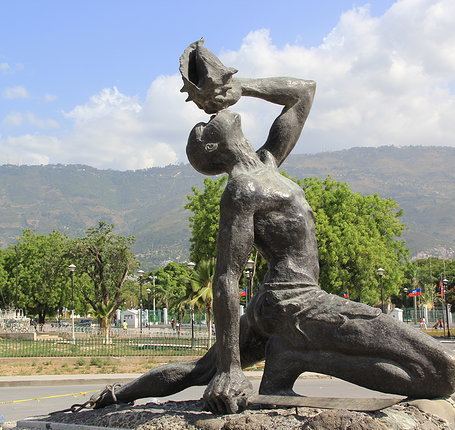Artist Albert Mangonès Completion date 22 September 1967 | Created 22 September 1967 | |
 | ||
Designer Created by Haitian sculptor Albert Mangonès Height 3.60 metres (11.8 ft) and 2.40 metres (7.9 ft) tall Similar National Palace, Musée du Panthéon National, Sans‑Souci Palace, Citadelle Laferrière, Stade Sylvio Cator | ||
Le Marron Inconnu de Saint-Domingue, shortened as Le Marron Inconnu ([lə ma.ʁɔ̃ ɛ̃.kɔ.ny], "The Unknown Slave"), also called Le Nègre Marron or Nèg Mawon ([nɛɡ ma.ʁɔ̃], "Maroon Man"), is a bronze statue of a runaway slave commemorating the abolishment of slavery and is in the capital of Port-au-Prince, Haiti. Designed by Haitian sculptor and architect Albert Mangonès (1917–2002) and completed on 22 September 1967, the sculpture serves a reminder of the call to rebellion in the colony of Saint-Domingue against the slave-holding France in 1791. It has become the nation's iconic symbol of freedom and is viewed in the world as a symbol for the freedom of black people.
Contents
Description
Construction of the statue was completed on 22 September 1967 by Albert Mangonès. It measures at 3.60 metres long by 2.40 metres high. The bust depicts a bronze near-naked fugitive, kneeling on one knee, torso arched, opposite leg stretched back, a broken chain at its left ankle, while holding a conch shell at its lips with its left hand, head tilted upward, while the other hand holds a machete at the ground to its right ankle.
Mangonès chose to use a passage from 1 Maccabees 14:3-9 of the Jerusalem Bible in the background of his sculpture on one of the two concrete panels that protect the "eternal flame" of freedom on the square surrounding the statue set in copper letters.
Recognized usage
In 1989, the United Nations adopted the statue as a central icon on postage stamps commemorating Article 4 of the Universal Declaration of Human Rights that states, "No one shall be held in slavery or servitude; slavery and the slave trade shall be prohibited in all their forms."
